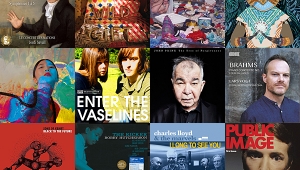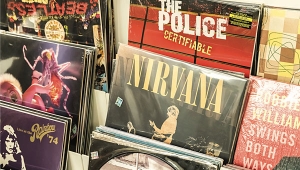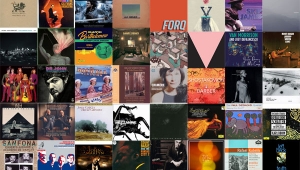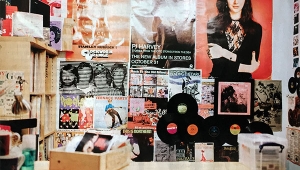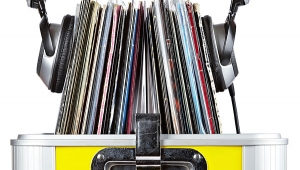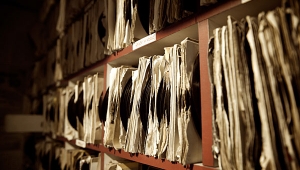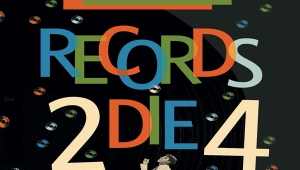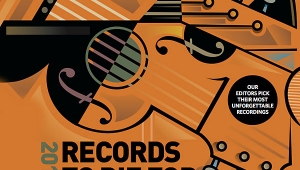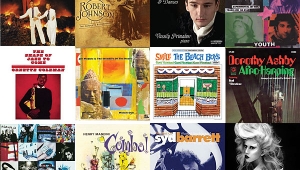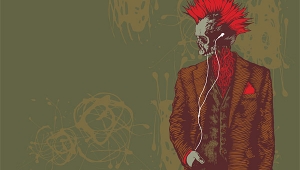| Columns Retired Columns & Blogs |
1991 Records To Die For Page 10
Thomas J. Norton
"Five top recordings, no more than 100 words on each, must be impeccable both sonically and musically."
BERLIOZ: Symphonie Fantastique
Varujan Kojian, Utah Symphony Orchestra
Reference Recordings RR-11CD (CD). Keith O. Johnson, eng.; Jeffrey Kaufman, prod. DDD. TT: 57:47
The "Fantastique" is a warhorse for a good reason---it's explosive, atmospheric, vulgar, visceral, chilling, and leaves the listener drained at the finish. A real crowd-pleaser. Which is why, I suppose, that it's so seldom performed live by major orchestras. Kojian's forces perform in a manner which would do justice to a "major" orchestra, and, while the Solti/Chicago Symphony recording on London---with its absolutely hair-raising final movement---remains my favorite (recorded) performance, its CD sound is raw and hard.
LEO KOTTKE: A Shout Toward Noon
Private Music 2007-2-P (CD only). Dan Wallin, eng.; Buell Neidlinger, prod. DDD. TT: 38:50
This album is likely to be found under "New Age"---whatever that means; to me it is simply an excellent album showcasing Loe Kottke's outstanding virtuosity on guitar (accompanied by cello and discreet synthesizer). It is all very laid-back and atmospheric. The recording is warm yet detailed, and serves the music and performance superbly. There are plenty of good guitar recordings around; for the past couple of years, this has been the one I reach for first. This album is likely to be found under "New Age"---whatever that means; to me it is simply an excellent album showcasing Loe Kottke's outstanding virtuosity on guitar (accompanied by cello and discreet synthesizer). It is all very laid-back and atmospheric. The recording is warm yet detailed, and serves the music and performance superbly. There are plenty of good guitar recordings around; for the past couple of years, this has been the one I reach for first.
ESTHER OFARIM: Esther
ATR CD 001 (CD only). Günther Zipelius, eng.; Erich Ferstl, prod. AAD. TT: 35:11
A collection of modern folk-songs---in Hebrew, French, Spanish, German, and Italian---performed by a little-known (in the US) Israeli singer with a lovely voice and appealing style. Virtually all of the songs are gems. ATR is a German audiophile label; you may have to hunt for this one from audiophile sources, not your local Tower outlet. English translations are not provided, but are little missed.
GREGORIO PANIAGUA: La Folia de la Spagna
Gregorio Paniagua, Atrium Musicae de Madrid
Harmonia Mundi 90.1050 (CD only). AAD. TT: 44:30
A folia is apparently some sort of mad dance, a perfect description of this recording. On the surface, it's a sprightly work for a small period-instrument group. Initially, all very refined and courtly---but punctuated throughout in a fashion that honors the tradition of P.D.Q. Bach and Spike Jones. I won't say more; it would spoil the fun. The performance is excellent---but then there's nothing with which to compare it.
RAMIREZ: Misa Criolla, Navidad en Verano, Navidad Nuestra
José Carreras, tenor; Coral Salvé de Laredo & Sociedad Coral de Bilbao choruses; José Luis Ocejo, Damian Sanchez, conductors
Philips 420 955-2 (CD only). John Newton, eng.; Job Maarse, prod. DDD. TT: 40:17
A superb sense of openness, spaciousness, and three-dimensional soundstage here is flawed only by occasional overloading on Carreras's crescendos. The work is moving, and the performance could hardly be bettered. The forces involve small instrumental group, chorus, and soloist. The generally restrained vocal dynamics demonstrate Carreras's strengths far better than his recent participation in the "big three" tenor shootout. For operaphobes, this is not an "operatic" work in the usual sense. It is, incidentally, also a fine Christmas album, while its lack of familiarity makes it listenable year-round.

Dick Olsher
PEDRO ALEDO: Cantos Antiguos y Cantos Nuevos
Spanish folksongs sung by Pedro Aledo, with guitar, lute, and percussion accompaniment
Pierre Verany PV 12793 (LP). Pierre Verany, prod. AAA. TT: 35:57
Folksongs have always been dear to me, no matter of what national origin. Most of the space here is devoted to traditional chants, which is just fine because it is these Cantos Antiguos that I find most charming. There's a germ of universal truth in any music that endures, and that is precisely the case with songs that have filtered through many generations. "La Rosa Enflorece" and "Tres Hermanicas" are but two examples of the old spanish traditionals that this recording serves so well. Pedro Aledo's bittersweet voice seems to communicate the essence of these songs with verve. The recording is executed with great skill. Image outlines are portrayed with excellent focus and palpability.
BRUCH: Collected Works for Cello & Orchestra
Julius Berger, cello; Antoni Wit, Polish National Radio Symphony Orchestra
ebs 6060 (CD only). DDD. TT: 37:04
A relatively recent discovery, this is the only CD to make my short list; it's that good. Of the four works, Ave Maria and the Adagio based on Celtic Melodies are premiere recordings and represent significant additions to the cello repertoire. The star attraction is still the well-known Kol Nidrei. This is one of those rare moments where evocative musical expression is well-served sonically. Although this is not a purist recording, the cello is highlighted, and the lush textures of the orchestra and the cello's rich timbre are very enjoyable. A spacious and organic soundstage of dramatic transparency enhances a sensitive and moving reading.
LAUDATE! Sacred vocal music
Anders Eby, Uppsala Akademiska Choir, Drottningholms Baroque Ensemble
Proprius PROP-7800 (LP). Bertil Alvig, eng. AAA. TT: 39:40
A total of seven Baroque choral compositions are featured, from the Duben collection at the University of Uppsala in Sweden. All of the composers are little known, but their music still touches my heart. Stefano Fabri's "Laudate pueri Dominum" amd Simon Vesi's "De profundis clamavi" are especially noteworthy. The acoustic of the recording venue is very naturally captured. The chorus, which is dominated by female voices, is convincingly localized within the soundstage with excellent width and depth and with just the right blend of intimacy and spaciousness.
MOZART: The Magic Flute
Pilar Lorengar, Pamina; Cristina Deutekom, Queen of the Night; Renate Holm, Papagena; Hermann Prey, Papageno; Dietrich Fischer-Dieskau, Speaker; Stuart Burrows, Tamino; Martti Talvela, Sarastro; Vienna State Opera Chorus, Vienna Philharmonic Orchestra, Georg Solti
London OSA-1397 (3 LPs, op). AAA. TT: 2:35:30
Solti's energetic and dramatic reading has continued to appeal to me over the years. What to my mind is an allegorical accounting of good vs evil benefits from a de-emphasis of Mozartian charm in favor of dramatic contrasts. The male voices are in superb form. Talvela as Sarastro and Fischer-Dieskau as the Speaker are particularly effective in adding a mystical dimension to their roles. Prey's Papageno is delightful, with a fine ear for dialog intonation. Overall, the female cast is not quite as strong. However, Holm as Papagena mates well with Prey. And Lorengar (Princess Pamina) infuses her sweet and pure timbre with a captivating innocence that provides a rare glimpse of what I believe Mozart wished to portray: universal love as an instrument for good. Also available on 3 CDs (London 414 568-2).
WALTON: Belshazzar's Feast
John Shirley-Quirk, André Previn, London Symphony Orchestra & Chorus
EMI SAN-324 (LP only, op). Christopher Bishop, Christopher Parker, engs. AAA.
This powerful masterpiece is tightly controlled by Previn, who coaxes a dynamic and committed performance from the LSO. The choral climaxes are particularly challenging and demand the most from a phono cartridge. I have returned to this recording again and again as a paradigm of how a large chorus and orchestra should be recorded.

Jon W. Poses
I've never been comfortable with "Best Of" compilations, which in effect is what Stereophile asked its contributing editors to demarcate for readers who requested the magazine present an "All-Time Recommended Recordings."
DEREK AND THE DOMINOS: Layla
Eric Clapton, guitars, lead vocals; Duane Allman, guitars; Bobby Whitlock, organ, piano, vocals, acoustic guitar; Carl Radle, bass, percussion; Jim Gordon, drums, percussion, piano
Atco SD 2-704 (2 LPs); Ron Albert, Chuck Kirkpatrick, Howie Albert, Carl Richardson, Mac Emmerman, engs.; Dominos, arrs., prods.; Tom Dowd, exec. prod. AAA. TT: 73:00
ALBERT COLLINS, ROBERT CRAY, JOHNNY COPELAND: Showdown!
Albert Collins, guitar, harmonica, vocals; Robert Cray, Johnny Copeland, guitars, vocals; Allen Batts, organ; Johnny B. Gayden, bass; Casey Jones, drums
Alligator AL/ALCD 4743 (LP/CD). Justin Niebank, eng.; Bruce Iglauer, Dick Shurman, prods.; Bruce Bromberg, co-prod. AAA/AAD. TT: 43:48
Both blues sessions are equally powerful. Both represent my guitar-slinging (but skip the athleticism, please) bias. Layla arrived in 1970, at a time when the recording industry and pop musicians began to display real maturity. Indeed, Layla---jointly showcasing Eric Clapton at his post-Cream, post-Blind Faith, pre-schlock best, and the late Duane Allman, still in his early 20s but well on his way to leaving an indelible mark---remains any guitar-player's dream. In a rare (and probably lucky) stroke of perfection, producer Tom Dowd bonded classic blues and R&B with the utmost instrumental clarity ("Nobody Knows You When You're Down and Out," "Key to the Highway," "It's Too Late," "Have You Ever Loved a Woman"). There's a successful reading of Jimi Hendrix's "Little Wing," and a handful of originals, now classics, the most notable being the title track and "Why Does Love Have To Be So Sad?" Layla marks that rare moment when all the forces meet at the right intersection.
THELONIOUS MONK & JOHN COLTRANE: Monk/Trane
Thelonious Monk, piano; John Coltrane, Coleman Hawkins, tenor sax; Gigi Gryce, alto sax; Ray Copeland, trumpet; Wilbur Ware, bass; Shadow Wilson, Art Blakey, drums
Milestone M47011 (2 LPs). Jack Higgins, eng. ('57); re-mastered by Brian Gardner ('73); Orrin Keepnews, prod. TT: 80:29
For much of the 1970s, Fantasy Records, which acquired the Prestige, Milestone, and Riverside catalogs, combined single LPs to create its valuable "Two-Fer" reissue series. Content-wise, there's never been a question; sometimes the sound missed, what with fadeouts, dropouts, etc. Monk/Trane may be the best all-around achievement of a very good batch---and that's saying a lot. Capturing and melding two giants---'Trane and Monk---in addition to providing them with accompanists that include Coleman Hawkins' sax and the late Art Blakey's skins on the front and back lines, respectively, is genius. To have Orrin Keepnews as producer only adds to the historical exactitude and aural delight of such explorations as Monk's "Epistrophy," "Ruby My Dear," "Trinkle, Tinkle," "Nutty," and "Monk's Mood." I get chills every time I hear Monk yell, "Coltrane, Coltrane" amid "Well You Needn't."
Footnote 8: The CD is bright!---JA
"Five top recordings, no more than 100 words on each, must be impeccable both sonically and musically."
The words jumped off the page. A great idea, I thought, as I perused Richard Lehnert's letter. But RL couldn't be serious about the length.
He was. This wasn't going to be easy. And the more I thought about it, the more difficult it became. I suspect my consternation was shared by most of the writers. Not only were they restricted to an unconscionable length---100 words is, after all, cruel and unusual punishment for writers who love to ruminate at the keyboard about their favorite subject; the selections themselves would be difficult. We all have our favorite recordings, of course. Our "desert island" selections. But I knew that the selections which I made here would not be the same ones I would choose for life among the coconuts. There, performance would of necessity take top---not equal---priority. Sound quality would still be of importance, of course, assuming that my desert island "system" was up to snuff and South Pacific Edison provided a reliable power source!
Furthermore, how to choose recordings impeccable in both sound and performance? There really is no such thing. Nor is there likely to be agreement among a broad cross-section of listeners as to what satisfies these requirements. And what about musical taste? Now there's a wrenching subject. How often have you played a recording for friends that stops you in your tracks every time, only to have them start a conversation halfway through? We all respond differently to a given piece of music and to a given performance.
And there's another difficulty---LP vs CD. Here each reviewer wrestles with his or her own feelings on matters analog and digital, tempered by real-world considerations. I can only speak for myself. In a different world, most---perhaps all---of my choices would be analog LP. But I have no desire to send the reader off on an endless search. Nor do I wish to add to the already relentless price pressures on the remaining stocks of sought-after LPs. I have therefore, with some reluctance, limited my recommendations to CDs---which should be more or less readily available. Others will weigh their priorities differently.
Of course, there is no "solution" to these problems. The choices of each reviewer are based on his or her own "best guess" at the time. Such choices are also limited---usually---to what is in our own collections at a given moment; tomorrow that magic recording may be found which renders everything else irrelevant. But for now, I think that you will at least find our recommendations interesting. And, we hope, rewarding as well. May the Christmas Dog leave lots of good listening under your tree.
BERLIOZ: Symphonie Fantastique
Varujan Kojian, Utah Symphony Orchestra
Reference Recordings RR-11CD (CD). Keith O. Johnson, eng.; Jeffrey Kaufman, prod. DDD. TT: 57:47
The "Fantastique" is a warhorse for a good reason---it's explosive, atmospheric, vulgar, visceral, chilling, and leaves the listener drained at the finish. A real crowd-pleaser. Which is why, I suppose, that it's so seldom performed live by major orchestras. Kojian's forces perform in a manner which would do justice to a "major" orchestra, and, while the Solti/Chicago Symphony recording on London---with its absolutely hair-raising final movement---remains my favorite (recorded) performance, its CD sound is raw and hard.
This version, in its (still available) LP guise, has long been an audiophile favorite. The CD is also superb, with one of the most astounding low-ends in existence. When you want to see what your system will really do, this will fill the bill nicely.
LEO KOTTKE: A Shout Toward Noon
Private Music 2007-2-P (CD only). Dan Wallin, eng.; Buell Neidlinger, prod. DDD. TT: 38:50
This album is likely to be found under "New Age"---whatever that means; to me it is simply an excellent album showcasing Loe Kottke's outstanding virtuosity on guitar (accompanied by cello and discreet synthesizer). It is all very laid-back and atmospheric. The recording is warm yet detailed, and serves the music and performance superbly. There are plenty of good guitar recordings around; for the past couple of years, this has been the one I reach for first. This album is likely to be found under "New Age"---whatever that means; to me it is simply an excellent album showcasing Loe Kottke's outstanding virtuosity on guitar (accompanied by cello and discreet synthesizer). It is all very laid-back and atmospheric. The recording is warm yet detailed, and serves the music and performance superbly. There are plenty of good guitar recordings around; for the past couple of years, this has been the one I reach for first.
ESTHER OFARIM: Esther
ATR CD 001 (CD only). Günther Zipelius, eng.; Erich Ferstl, prod. AAD. TT: 35:11
A collection of modern folk-songs---in Hebrew, French, Spanish, German, and Italian---performed by a little-known (in the US) Israeli singer with a lovely voice and appealing style. Virtually all of the songs are gems. ATR is a German audiophile label; you may have to hunt for this one from audiophile sources, not your local Tower outlet. English translations are not provided, but are little missed.
The sound---from an analog master---ranges from good to superb (the mix varies somewhat from cut to cut). My early-'80s LP version is airier, but often edgy and overmodulated and generally less listenable than the CD. The latter, played at the right playback level, is magical.
GREGORIO PANIAGUA: La Folia de la Spagna
Gregorio Paniagua, Atrium Musicae de Madrid
Harmonia Mundi 90.1050 (CD only). AAD. TT: 44:30
A folia is apparently some sort of mad dance, a perfect description of this recording. On the surface, it's a sprightly work for a small period-instrument group. Initially, all very refined and courtly---but punctuated throughout in a fashion that honors the tradition of P.D.Q. Bach and Spike Jones. I won't say more; it would spoil the fun. The performance is excellent---but then there's nothing with which to compare it.
I've often used this as a CD reference for soundstaging, transients, and dynamics (watch the playback level---there are some surprises here). The LP is better in the expected ways, but sounds decidedly squashed in the more explosive portions of the work.
RAMIREZ: Misa Criolla, Navidad en Verano, Navidad Nuestra
José Carreras, tenor; Coral Salvé de Laredo & Sociedad Coral de Bilbao choruses; José Luis Ocejo, Damian Sanchez, conductors
Philips 420 955-2 (CD only). John Newton, eng.; Job Maarse, prod. DDD. TT: 40:17
A superb sense of openness, spaciousness, and three-dimensional soundstage here is flawed only by occasional overloading on Carreras's crescendos. The work is moving, and the performance could hardly be bettered. The forces involve small instrumental group, chorus, and soloist. The generally restrained vocal dynamics demonstrate Carreras's strengths far better than his recent participation in the "big three" tenor shootout. For operaphobes, this is not an "operatic" work in the usual sense. It is, incidentally, also a fine Christmas album, while its lack of familiarity makes it listenable year-round.
Dick Olsher
PEDRO ALEDO: Cantos Antiguos y Cantos Nuevos
Spanish folksongs sung by Pedro Aledo, with guitar, lute, and percussion accompaniment
Pierre Verany PV 12793 (LP). Pierre Verany, prod. AAA. TT: 35:57
Folksongs have always been dear to me, no matter of what national origin. Most of the space here is devoted to traditional chants, which is just fine because it is these Cantos Antiguos that I find most charming. There's a germ of universal truth in any music that endures, and that is precisely the case with songs that have filtered through many generations. "La Rosa Enflorece" and "Tres Hermanicas" are but two examples of the old spanish traditionals that this recording serves so well. Pedro Aledo's bittersweet voice seems to communicate the essence of these songs with verve. The recording is executed with great skill. Image outlines are portrayed with excellent focus and palpability.
BRUCH: Collected Works for Cello & Orchestra
Julius Berger, cello; Antoni Wit, Polish National Radio Symphony Orchestra
ebs 6060 (CD only). DDD. TT: 37:04
A relatively recent discovery, this is the only CD to make my short list; it's that good. Of the four works, Ave Maria and the Adagio based on Celtic Melodies are premiere recordings and represent significant additions to the cello repertoire. The star attraction is still the well-known Kol Nidrei. This is one of those rare moments where evocative musical expression is well-served sonically. Although this is not a purist recording, the cello is highlighted, and the lush textures of the orchestra and the cello's rich timbre are very enjoyable. A spacious and organic soundstage of dramatic transparency enhances a sensitive and moving reading.
LAUDATE! Sacred vocal music
Anders Eby, Uppsala Akademiska Choir, Drottningholms Baroque Ensemble
Proprius PROP-7800 (LP). Bertil Alvig, eng. AAA. TT: 39:40
A total of seven Baroque choral compositions are featured, from the Duben collection at the University of Uppsala in Sweden. All of the composers are little known, but their music still touches my heart. Stefano Fabri's "Laudate pueri Dominum" amd Simon Vesi's "De profundis clamavi" are especially noteworthy. The acoustic of the recording venue is very naturally captured. The chorus, which is dominated by female voices, is convincingly localized within the soundstage with excellent width and depth and with just the right blend of intimacy and spaciousness.
MOZART: The Magic Flute
Pilar Lorengar, Pamina; Cristina Deutekom, Queen of the Night; Renate Holm, Papagena; Hermann Prey, Papageno; Dietrich Fischer-Dieskau, Speaker; Stuart Burrows, Tamino; Martti Talvela, Sarastro; Vienna State Opera Chorus, Vienna Philharmonic Orchestra, Georg Solti
London OSA-1397 (3 LPs, op). AAA. TT: 2:35:30
Solti's energetic and dramatic reading has continued to appeal to me over the years. What to my mind is an allegorical accounting of good vs evil benefits from a de-emphasis of Mozartian charm in favor of dramatic contrasts. The male voices are in superb form. Talvela as Sarastro and Fischer-Dieskau as the Speaker are particularly effective in adding a mystical dimension to their roles. Prey's Papageno is delightful, with a fine ear for dialog intonation. Overall, the female cast is not quite as strong. However, Holm as Papagena mates well with Prey. And Lorengar (Princess Pamina) infuses her sweet and pure timbre with a captivating innocence that provides a rare glimpse of what I believe Mozart wished to portray: universal love as an instrument for good. Also available on 3 CDs (London 414 568-2).
WALTON: Belshazzar's Feast
John Shirley-Quirk, André Previn, London Symphony Orchestra & Chorus
EMI SAN-324 (LP only, op). Christopher Bishop, Christopher Parker, engs. AAA.
This powerful masterpiece is tightly controlled by Previn, who coaxes a dynamic and committed performance from the LSO. The choral climaxes are particularly challenging and demand the most from a phono cartridge. I have returned to this recording again and again as a paradigm of how a large chorus and orchestra should be recorded.
Jon W. Poses
I've never been comfortable with "Best Of" compilations, which in effect is what Stereophile asked its contributing editors to demarcate for readers who requested the magazine present an "All-Time Recommended Recordings."
"All-time?" I asked RL. He confirmed the assignment, reiterating that performance and sound must be equal partners in judgment. I found it impossible to pick---with clear conscience and unwavering self-assuredness, five---and only five---"greatest hits." Despite fingering my entire LP and CD collections and several friends' counterparts, I could never say to myself, "Yes, these five babies belong in everyone's collection.
Limitations notwithstanding, I did, I'm delighted to report, arrive at a compromise solution. Here's my budget reduction process: three recordings, one label, and an engineer. Each has had dramatic, if not irrefutable, impact.
DEREK AND THE DOMINOS: Layla
Eric Clapton, guitars, lead vocals; Duane Allman, guitars; Bobby Whitlock, organ, piano, vocals, acoustic guitar; Carl Radle, bass, percussion; Jim Gordon, drums, percussion, piano
Atco SD 2-704 (2 LPs); Ron Albert, Chuck Kirkpatrick, Howie Albert, Carl Richardson, Mac Emmerman, engs.; Dominos, arrs., prods.; Tom Dowd, exec. prod. AAA. TT: 73:00
ALBERT COLLINS, ROBERT CRAY, JOHNNY COPELAND: Showdown!
Albert Collins, guitar, harmonica, vocals; Robert Cray, Johnny Copeland, guitars, vocals; Allen Batts, organ; Johnny B. Gayden, bass; Casey Jones, drums
Alligator AL/ALCD 4743 (LP/CD). Justin Niebank, eng.; Bruce Iglauer, Dick Shurman, prods.; Bruce Bromberg, co-prod. AAA/AAD. TT: 43:48
Both blues sessions are equally powerful. Both represent my guitar-slinging (but skip the athleticism, please) bias. Layla arrived in 1970, at a time when the recording industry and pop musicians began to display real maturity. Indeed, Layla---jointly showcasing Eric Clapton at his post-Cream, post-Blind Faith, pre-schlock best, and the late Duane Allman, still in his early 20s but well on his way to leaving an indelible mark---remains any guitar-player's dream. In a rare (and probably lucky) stroke of perfection, producer Tom Dowd bonded classic blues and R&B with the utmost instrumental clarity ("Nobody Knows You When You're Down and Out," "Key to the Highway," "It's Too Late," "Have You Ever Loved a Woman"). There's a successful reading of Jimi Hendrix's "Little Wing," and a handful of originals, now classics, the most notable being the title track and "Why Does Love Have To Be So Sad?" Layla marks that rare moment when all the forces meet at the right intersection.
Alligator Records' creator Bruce Iglauer duplicated the feat some 15 years later when he assembled Showdown!, a consortium comprised of the most important blues artists in modern history: Albert Collins, young upstart Robert Cray, and the persistent Johnny Copeland. Iglauer & Co. proceeded to unleash a nine-piece summit epitomized by the likes of "Black Cat Bone." Showdown! overshadows every blues session that has followed since, as well as any that preceded it, dating back to Layla. Collins's "The Moon Is Full," a funk-filled and spacious adventure, epitomizes up-to-the-minute but authentic blues. Remember, this record arrived in 1985, just before Cray hit the big time. He's humble, honored to perform with two of his long-time idols. Forget "Smoking Gun"---Cray's never come close to this again. Showdown! stands as the blues document of the '80s. (Footnote 8)
THELONIOUS MONK & JOHN COLTRANE: Monk/Trane
Thelonious Monk, piano; John Coltrane, Coleman Hawkins, tenor sax; Gigi Gryce, alto sax; Ray Copeland, trumpet; Wilbur Ware, bass; Shadow Wilson, Art Blakey, drums
Milestone M47011 (2 LPs). Jack Higgins, eng. ('57); re-mastered by Brian Gardner ('73); Orrin Keepnews, prod. TT: 80:29
For much of the 1970s, Fantasy Records, which acquired the Prestige, Milestone, and Riverside catalogs, combined single LPs to create its valuable "Two-Fer" reissue series. Content-wise, there's never been a question; sometimes the sound missed, what with fadeouts, dropouts, etc. Monk/Trane may be the best all-around achievement of a very good batch---and that's saying a lot. Capturing and melding two giants---'Trane and Monk---in addition to providing them with accompanists that include Coleman Hawkins' sax and the late Art Blakey's skins on the front and back lines, respectively, is genius. To have Orrin Keepnews as producer only adds to the historical exactitude and aural delight of such explorations as Monk's "Epistrophy," "Ruby My Dear," "Trinkle, Tinkle," "Nutty," and "Monk's Mood." I get chills every time I hear Monk yell, "Coltrane, Coltrane" amid "Well You Needn't."
As for my final two choices: one's a label, the other's an engineer---and they're inseparable. The label: Blue Note Records. Despite the ups and downs, flirtations with commercialization, and its current subsidiary status, "The Finest In Jazz Since 1939" still sets the standard. Its reissue program deserves just recognition; it's jazz history itself. The label entered what many consider its zenith during the 1950s and 1960s, when bebop turned to hard bop and straight-ahead was king. Soundwise, every instrument could not only be heard, but also was heard clearly, the ever-shifting emphasis coming and going at just the right moment.
The label's many great staff artists were made to sound even better at the hands of one person: engineer Rudy Van Gelder. His name remains synonymous with Blue Note, synonymous with jazz. To this day, the somewhat paranoid European is reticent to allow anyone---save producers---near his now-famous Englewood Cliffs, New Jersey, studios. Maybe that's a good thing.
Footnote 8: The CD is bright!---JA
- Log in or register to post comments

